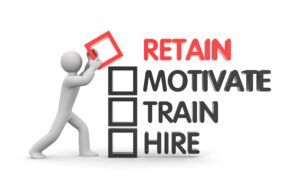To the delight of business and HR leaders, employees are prioritizing stability at work. The Big Stay of 2023 is sticking around for 2024. Here’s why.
After the “Great Resignation” of 2020-2022, where waves of employees voluntarily resigned from their jobs, we started seeing a “Big Stay” trend in the spring of 2023. To the delight of business and HR leaders, employees started to settle into their new positions, prioritizing stability at work. The shift wasn’t accidental or random. And it looks like the Big Stay of 2023 continues in 2024. Here’s why.
What is the Big Stay?
We like this definition, from a May 2023 Forbes article: “The ‘Big Stay’ is a term used to describe the trend of workers hunkering down and remaining in their current jobs for more extended periods of time. This trend contrasts the Great Resignation, which saw a record number of workers – 4 million each month – quitting their jobs in 2021 for better pay and benefits, work flexibility, an enhanced work-life balance and career advancement.”
ADP Research Institute’s Chief Economist, Dr. Nela Richardson, first referred to the Big Stay earlier that month when reporting a slowdown in worker turnover compared to the previous two years. The term caught on and aptly captures the rebound trend we’re experiencing now.
Why is the Big Stay happening?
There’s never a singular reason for a workforce trend. In this case, there are numerous factors that support today’s Big Stay.
- Job-switching is less financially compelling. In the early days of the Great Resignation, we were in the throes of the COVID-19 pandemic. Some employees stepped away from the labor market entirely, either to minimize the health risks of in-person work or to care for children who were suddenly pushed to virtual education from home. At the same time, companies were pivoting business operations to meet new market demands and scrambling for workers during a labor shortage. The combination created lucrative pay-outs to job-hoppers who switched to higher-paying jobs—often making a series of job changes for more money or other desired benefits.
Now, wage increases for workers who change jobs have slowed. A more stabilized labor market and few wage premiums means the financial advantages of changing jobs have diminished.

- Economic and geopolitical uncertainty. While the much-anticipated recession of 2023 never materialized, the uncertainty associated with inflation, the political climate, and wars in other parts of the world are leading employees to value job security. Layoffs, too, are still making headlines in today’s news – especially in the technology sector.
For employees who see their employers as financially stable, it’s tough to leave for an unknown situation.
- Better job fit. Many who made a big job move two years ago ultimately landed in a good spot and they are happier. For some who had been discontent in their jobs for a while, it was time to leave.
Whether they moved to another part of the country to embrace virtual work and live their best lives, started a passion project, or switched to an employer with a more aligned culture or mission, they are where they want to be and are not looking to change jobs now.
- Employers are listening. Over the past year or two, business and HR leaders placed greater emphasis on employee experience and engagement to retain the talent and skills in their workforce. It seems to be working.
Employee satisfaction is up. Mercer’s 2023-2024 Inside Employees’ Minds study, “US employers’ investments in pay, benefits, and flexibility have resulted in employees having more positive attitudes about work.”
How to keep it going
Many variables related to workforce trends cannot be controlled by an employer. But you can keep doing the things that matter most to your employees:
- Listen. Stay tuned in to find out what’s most important to your workers. If there are changes that you can reasonably accommodate, do it! Think along the lines of flexibility, employee recognition, collaboration, and other elements of a winning culture.
- Communicate. Share your goals and how employees will help you get where you need to go. Highlight the changes you’re making, and why. Showcase wins – from employee and team successes to support for local nonprofits.
- Watch. Monitor financial, geopolitical, and market trends, so you are always preparing and adapting for what’s next.
- Build new skills, upskill, and reskill. Stay transparent about the skills you need across the workforce. Support employees in gaining new skills, reskilling, and/or upskilling to develop the skills and competencies you (and they) need for success.
- Accept. Some truths and workforce influences are out of your control. Financial and workforce trends are cyclical. Remote and hybrid work is expected to be a permanent feature of white-collar jobs. Younger generations of workers are still quite mobile. Artificial intelligence is here to stay. Pay attention to those trends and realities that are out of your control, so you can adapt appropriately.
If you’re experiencing a Big Stay, now is the best time to adopt best practices for employee retention that will help you weather the next downturn.
For ideas to optimize your Big Stay initiative by prioritizing your workforce skills and competencies, download our Competency Management Toolkit. Or contact us to see if Avilar’s WebMentor Skills™ competency management systems may support your team.
RELATED RESOURCES
The Stay Conversation: It’s How to Retain Top Talent
The Importance of Transparency and the Key to Retention
How to Use Competency Management for the Best Employee Experience
The Future of Workforce Management: 6 Trends With Staying Power for 2024


